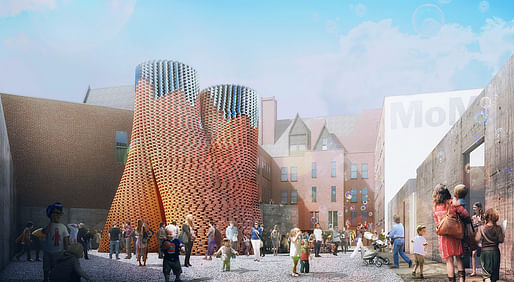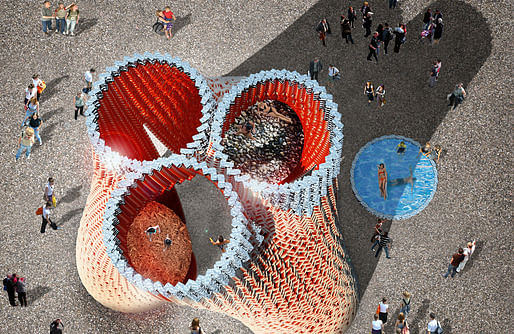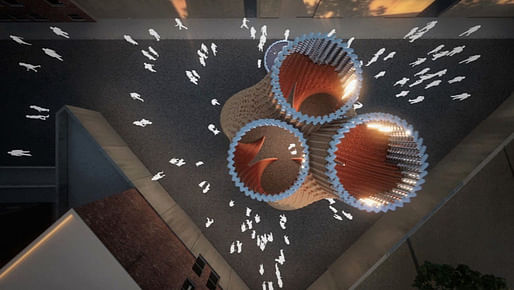

After winning the 2014 Young Architects Program out of five finalists, emerging architect David Benjamin and his firm, The Living will temporarily transform the outdoor courtyard of MoMA PS1 in Long Island City, New York when the summer season rolls in.
YAP projects had to provide seating, shade, and water, and also follow guidelines that address environmental issues and sustainability. The Living's proposal, titled "Hy-Fi", will feature circular organic brick towers made of corn stalk and living root structures. Set to open in late June, the temporary installation will be a memorable summer spectacle.
Here's more detail into the project's design:
"Using biological technologies combined with cutting-edge computation and engineering to create new building materials, The Living will use a new method of bio-design, resulting in a structure that is 100% organic material. The structure temporarily diverts the natural carbon cycle to produce a building that grows out of nothing but earth and returns to nothing but earth—with almost no waste, no energy needs, and no carbon emissions.
This approach offers a new vision for society's approach to physical objects and the built environment. It also offers a new definition of local materials, and a direct relationship to New York State agriculture and innovation culture, New York City artists and non-profits, and Queens community gardens."

"Hy-Fi is a circular tower of organic and reflective bricks, which were designed to combine the unique properties of two new materials. The organic bricks are produced through an innovative combination of corn stalks (that otherwise have no value) and specially-developed living root structures, a process that was invented by Ecovative, an innovative company that The Living is collaborating with.
The reflective bricks are produced through the custom-forming of a new daylighting mirror film invented by 3M. The reflective bricks are used as growing trays for the organic bricks, and then they are incorporated into the final construction before being shipped back to 3M for use in further research. The organic bricks are arranged at the bottom of the structure and the reflective bricks are arranged at the top to bounce light down on the towers and the ground."
"The structure inverts the logic of load-bearing brick construction and creates a gravity-defying effect—instead of being thick and dense at the bottom, it is thin and porous at the bottom. The structure is calibrated to create a cool micro-climate in the summer by drawing in cool air at the bottom and pushing out hot air at the top."

"The structure creates mesmerizing light effects on its interior walls through reflected caustic patterns. Hy-Fi offers a familiar—yet completely new—structure in the context of the glass towers of the New York City skyline and the brick construction of the MoMA PS1 building. And overall, the structure offers shade, color, light, views, and a future-oriented experience that is designed to be refreshing, thought-provoking, and full of wonder and optimism."
7 Comments
My initial reaction to this scheme centers around that phrase "self assembling" that shows up in the video around the 00:36 mark. The phrase appears at the same time an animation shows the towers growing. The self assembly in play here though actually seems to be at the micro-scale, a biochemical process that binds the organic matter of the cast bricks together. This is slightly problematic. The implication is that the tower will grow spontaneously, but as we know, these PS1 YAP projects depend heavily on the often donated labor of students, friends, and volunteers. If the self assembly that occurs here is really just the curing of a brick that will later decompose, that should be clearer.
It seems a point to nitpick, but it leads directly to issues of labor tied to signature projects that keep coming into play, whether in Queens, the UAE, or in the offices of firms that employ unpaid interns. If we keep pretending that modular, doubly curved surfaces grow on their own like plants, we can easily lose sight of the people who actually assemble both the digital models and the physical objects. The clearest writeup of these questions as they apply to PS1 is Enrique Ramirez's essay here (also published in CLOG SCI-FI): http://www.aggregat456.com/2009/02/lv-426-or-labors-of-ps-1.html
Maybe there is a plan in place to organize and compensate the labor of the individuals who will lay the brick, and I'm being unfair to The Living, whose work I admire greatly. Maybe they'll build it with quadcopter drones? But even so, that plan is underplayed in the presentation, in favor of some cliches about assembly that seem to look forward, but are actually stuck in the past.
MOMA doesn;t collect building and really doesn't care about Architecture. They have their own vision which of course includes unpaid interns working for Architecture Firms.
Hear Hear, Fred.
Yes I couldn't have said it better Fred, it is so easy to use words to imply a reality much more interesting then the real world will allow!
That's a good point Fred. Biology is a wonderful source of theoretical and visual inspiration, but inanimate matter must be assembled by somebody. On the otherhand, it's complexity might call for a true master mason's skill. I wonder who they have in mind to build this.
I also wonder how the bricks stick together...are they pinned or is there some adhesion material, becasue no matter how light, you wouldn't want an accidental demolition. Another question about this kind of composite construction member is can it be decomposed organically? And how will they keep kids from climbing this thing?
Whatever their answers, it's a beautiful structure to my eyes.
It is a gorgeous piece.
This is a tricky topic, because it goes right to the question of externalities. In one sense, and I say this as someone who knows a few previous winners and runners up personally, and has several good friends who have donated labor to various PS1 installations, the responsibility lies at the feet of MoMA, for not paying essentially a "living wage" that would cover the huge amounts of labor necessary for these. But in another sense, say the MoMA stipend is x, it might be the case that the competing architects would always submit proposals whose actual costs would be x*1.5 or more, knowing that this extravagance might give them an edge. Remember that shiny house thing in Flint, Michigan last year?
Basically competitions kind of suck, and this one is probably one of those where the designers, after the buzz of winning wears off, look around and go "crap, now we have to actually build this thing", and they burn a lot of real capital and social capital to get it done.
It is compostable, making it all the more awsome.
http://www.theatlantic.com/technology/archive/2014/02/soon-to-grace-the-nyc-skyline-towers-made-of-fungus/283646/
Block this user
Are you sure you want to block this user and hide all related comments throughout the site?
Archinect
This is your first comment on Archinect. Your comment will be visible once approved.